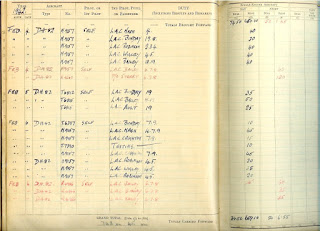Despite putting in a transfer request to "nightfighters", the summer months of 1942 found my Grandfather, H. C. Kelsey, still training pilots in Tiger Moths and Miles Magisters for 21 E.F.T.S. at Booker, Marlow. However, the eagle eyed amongst you will have seen something interesting in this scan of his Log Book....
In brackets after the name 'Brown' is the word (Cpl). Cpl refers to Corporal and there wasn't and still isn't a rank of Corporal in the RAF. So what's going on?
Well, this is all about a new initiative in warfare for the British army. Following the Germans' airborne attack on Crete with Parachutists and Gliders, Churchill decided to copy the idea and set up a British Army Air Corps. One part of this Army Corps was the Glider pilot regiment, which was inaugurated on 24th February 1942 and made use of the RAF (Brylcreem Boys) to train army recruits (Brown Jobs) to fly.
So it looks like my Grandfather was caught up in this new idea and for the next few months he put the following army personnel through their paces:-
Cpl Brown Cpl Flodman Cpl Percy Cpl Owen Cpl Bence
Cpl Wood Cpl Prince Cpl Urquhart Cpl McMillen 2/Lt Cairns
Cpl Potts Lt Anderson Cpl May Cpl Watson Cpl Bland
Cpl Evans Cpl Berry Cpl Tilling Cpl Binnington
Cpl Wright Cpl Travis Sgt Sinclair Cpl Purcell Cpl Martin
Cpl Ryans Cpl Baglin
Here's a group photo I found on Google of a Glider Pilot force being trained at 21 EFTS in July 1942, but there are no names attached, unfortunately.
Initially, these squaddies were delighted to be part of this new Regiment, with one recruit, Staff Sgt Victor Miller, writing in his book "Nothing is Impossible", that the food was excellent compared to normal army food, time off was given ungrudgingly and most weekends were free. On top of that, being trained at 21 EFTS at Booker was "easygoing and fascinating" as well as being the closest to the London nightspots of all the training aerodromes.
The motto of this Regiment was "Nothing is Impossible", but the trainees that were under my grandfather's tutelage were destined for a very tough war. Of the men in the list above, I have discovered that Lt Cairns was awarded a posthumous VC in the Second Chindit Expedition. Having landed by glider behind the Japanese lines in Burma in 1944, Lt Cairns was involved in a hand-to-hand battle on "Pagoda Hill" when, despite having his arm hacked off by a Japanese officer, he shot his attacker at point blank range, picked up the sword which had severed his arm and leading his men on, proceeded to slash at every Japanese soldier in reach. The other men in the list whom I have found mention of on the internet are Cpl Binnington and Cpl Bland, who took part in Operation Market Garden, the famous 'Bridge Too Far' balls-up at Arnhem in May 1945. The Glider Pilot Regiment suffered 90% casualties at Arnhem, so you can imagine that not many of the trainees my Grandfather dealt with made it through to the end of the war.
All these heroics are in the future, strange to think of 1944/5 as the future, but in Summer 1942 my Grandfather knew nothing of the death and carnage that was about to hit his trainees. Although his life as a pilot trainer was not without hazard. Indeed, casualties at all British RAF airfields during training were running at about 3%, this included both trainees and flying tutors. However, RAF Booker seems to have escaped relatively lightly. That's not to say there were no casualties and it seems that Cpl Brown, who lead me into this story of RAF and Army co-operation, was not to survive his time training at 21 EFTS. On the 4th Sept 1942, whilst "going solo", Corporal P. E. Brown's Tiger Moth swung on take-off, stalled and spun into the ground, killing the pilot. The date is marked in my Grandfather's Log Book with just a break of two days, by 7th Sept. everyone at the base was back to work as usual. "Keep Calm and Carry On"
1942 was another bad year for the British and her allies. With the retreat in the face of the Japanese and the fall of Singapore, the fall of Sevastopol and the loss of Tobruk, combined with the shortages due to sinking of ships of the Atlantic convoys, the Brits at home would have been forgiven for thinking they may not win this War. In fact, on July 2nd, Churchill faced a vote of "no confidence" in the Commons due to his handling of the War. He only survived this vote by talking up the "steady resistance" of the Russians.
But July 1942 was also an important date for the War, when on the 4th July, United States Army Air Force (USAAF) bomber crews, flying RAF Boston aircraft from RAF Swanton Morley, took part in operations in Europe for the first time attacking enemy airfields in Holland.










